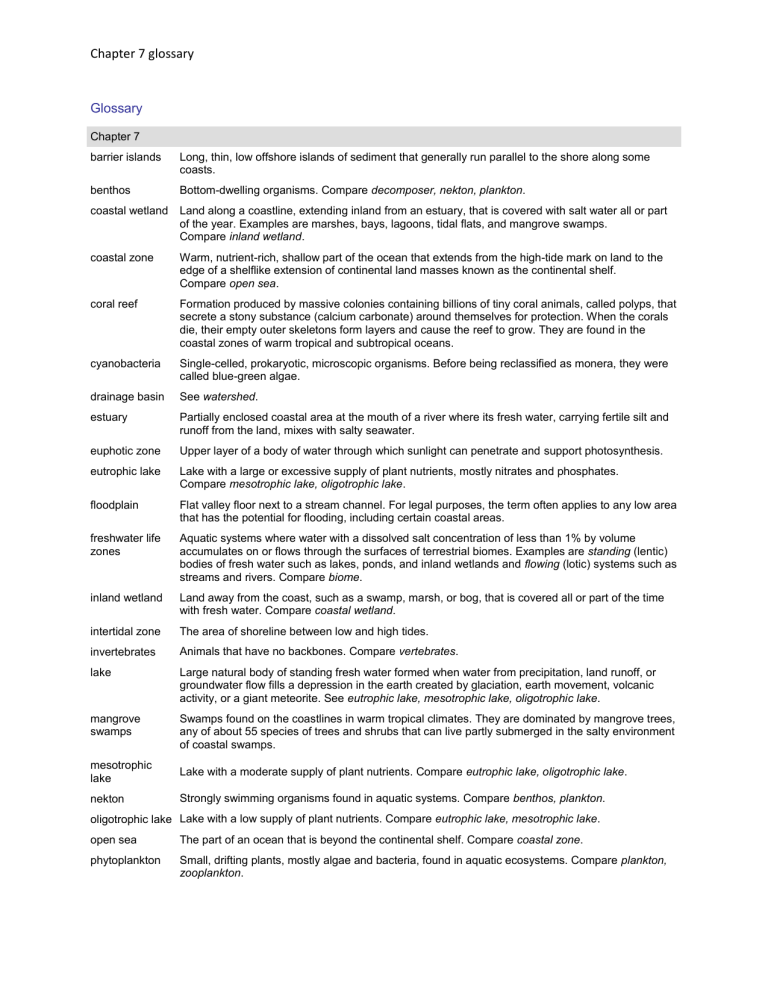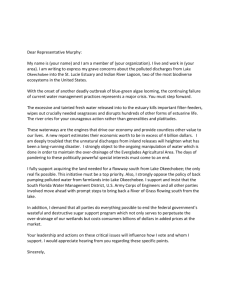chapter 7 Glossary - CarrollEnvironmentalScience

Chapter 7 glossary
Glossary
Chapter 7 barrier islands Long, thin, low offshore islands of sediment that generally run parallel to the shore along some coasts. benthos Bottom-dwelling organisms. Compare decomposer, nekton, plankton . coastal wetland Land along a coastline, extending inland from an estuary, that is covered with salt water all or part of the year. Examples are marshes, bays, lagoons, tidal flats, and mangrove swamps.
Compare inland wetland . coastal zone coral reef
Warm, nutrient-rich, shallow part of the ocean that extends from the high-tide mark on land to the edge of a shelflike extension of continental land masses known as the continental shelf.
Compare open sea .
Formation produced by massive colonies containing billions of tiny coral animals, called polyps, that secrete a stony substance (calcium carbonate) around themselves for protection. When the corals die, their empty outer skeletons form layers and cause the reef to grow. They are found in the coastal zones of warm tropical and subtropical oceans. cyanobacteria Single-celled, prokaryotic, microscopic organisms. Before being reclassified as monera, they were called blue-green algae. drainage basin See watershed . estuary Partially enclosed coastal area at the mouth of a river where its fresh water, carrying fertile silt and runoff from the land, mixes with salty seawater. euphotic zone Upper layer of a body of water through which sunlight can penetrate and support photosynthesis. eutrophic lake Lake with a large or excessive supply of plant nutrients, mostly nitrates and phosphates.
Compare mesotrophic lake, oligotrophic lake . floodplain Flat valley floor next to a stream channel. For legal purposes, the term often applies to any low area that has the potential for flooding, including certain coastal areas. freshwater life zones
Aquatic systems where water with a dissolved salt concentration of less than 1% by volume accumulates on or flows through the surfaces of terrestrial biomes. Examples are standing (lentic) bodies of fresh water such as lakes, ponds, and inland wetlands and flowing (lotic) systems such as streams and rivers. Compare biome . inland wetland Land away from the coast, such as a swamp, marsh, or bog, that is covered all or part of the time with fresh water. Compare coastal wetland . intertidal zone The area of shoreline between low and high tides. invertebrates Animals that have no backbones. Compare vertebrates . lake mangrove swamps
Large natural body of standing fresh water formed when water from precipitation, land runoff, or groundwater flow fills a depression in the earth created by glaciation, earth movement, volcanic activity, or a giant meteorite. See eutrophic lake, mesotrophic lake, oligotrophic lake .
Swamps found on the coastlines in warm tropical climates. They are dominated by mangrove trees, any of about 55 species of trees and shrubs that can live partly submerged in the salty environment of coastal swamps. mesotrophic lake nekton
Lake with a moderate supply of plant nutrients. Compare eutrophic lake, oligotrophic lake
Strongly swimming organisms found in aquatic systems. Compare benthos, plankton .
. oligotrophic lake Lake with a low supply of plant nutrients. Compare eutrophic lake, mesotrophic lake . open sea The part of an ocean that is beyond the continental shelf. Compare coastal zone . phytoplankton Small, drifting plants, mostly algae and bacteria, found in aquatic ecosystems. Compare plankton, zooplankton .
Chapter 7 glossary
plankton runoff stream Flowing body of surface water. Examples are creeks and rivers. surface water Precipitation that does not infiltrate the ground or return to the atmosphere by evaporation or transpiration. See runoff . Compare groundwater . thermocline Zone of gradual temperature decrease between warm surface water and colder deep water in a lake, reservoir, or ocean. transpiration
Small plant organisms (phytoplankton) and animal organisms (zooplankton) that float in aquatic ecosystems.
Fresh water from precipitation and melting ice that flows on the earth's surface into nearby streams, lakes, wetlands, and reservoirs. See reliable runoff, surface runoff, surface water. Compare groundwater . ultraplankton vertebrates watershed zooplankton
Process in which water is absorbed by the root systems of plants, moves up through the plants, passes through pores (stomata) in their leaves or other parts, and evaporates into the atmosphere as water vapor.
Photosynthetic bacteria no more than 2 micrometers wide.
Animals that have backbones. Compare invertebrates .
Land area that delivers water, sediment, and dissolved substances via small streams to a major stream (river).
Animal plankton. Small floating herbivores that feed on plant plankton (phytoplankton).
Compare phytoplankton .








